Articles
"Design in Industry" Exhibition, National Gallery of Canada, 1946:
Turning Bombers into Lounge Chair
Abstract
Industrial design is a subject particularly suited to material culture analysis. The story of the evolution of a national school of design links twentieth-century decorative arts with the interests of historians of technology, society, economics and art. This article considers the issues and problems facing the industrial design profession in post-war Canada. The 1946 National Gallery of Canada exhibition, "Design in Industry," is used to focus the discussion. An important event in its own right, the exhibition illustrated the close relationship between the furniture and aviation industries during the war years, the challenges presented by the adaptation of new materials to product design in the immediate post-war period and the aspirations of the National Gallery to encourage the development of a Canadian school of design.
Résumé
L'esthétique industrielle se prête particulièrement bien à l'analyse de la culture matérielle. L'évolution d'une école nationale de stylisme révèle un aspect des arts décoratifs du XXe siècle qui n'est pas sans intéresser les historiens de la technologie, de la société, de l'économie et de l'art. Cet article étudie les problèmes qui se posaient aux professionnels de l'esthétique industrielle après la guerre au Canada. L'étude s'attarde principalement à l'exposition d'esthétique industrielle qui a eu lieu au Musée des beaux-arts en 1946. Manifestation importante en soi, cette exposition illustrait bien les liens étroits qui s'étaient créés entre les industries de l'ameublement et de l'aviation pendant la guerre, les difficultés que posait l'utilisation de matériaux nouveaux dans les produits d'après-guerre et le désir du Musée des beaux-arts de voir se développer une école canadienne de stylisme.
1 There is an increasing interest among institutional and private collectors for the mass-produced utensils and furniture that can be referred to as the post-war school of industrial design. The last half of the 1940s is of interest as an introduction to the fundamental changes in life-style that resulted from an unprecedented scale of industrialization and demand for housing in the 1950s in Europe and North America. The industrial designer's problem-solving skills were called upon as never before to determine product efficiency in mass production. The 1950s are often depicted as a prosperous and contented decade because the quality of life was improved immensely with the wide availability of consumer goods. Artifacts manufactured during these years can reflect how society had reassessed its relationship to the machine and adapted to the reality of pervasive market forces.
2 Exhibitions such as "Design since 1945," held at the Philadelphia Museum of Art in 1983, "High Styles: Twentieth Century American Design," shown at the Whitney Museum of American Art in 1985, or "Seduced and Abandoned: Modern Furniture Design in Canada," presented at the Art Gallery of Harbourfront in November 1985, inspire great interest in the fashionable collectable. Yet they contribute little to our understanding of why the late 1940s and the 1950s were so crucial to the beginning of a tradition of consciously organized industrial design in Canada and most other industrialized centres in the world.
3 Industrial design is a subject well suited to the study of material history, incorporating as it does the multiple complexities of the twentieth-century decorative arts. A full analysis of industrial design must interweave the interests of historians of technology, society, economics and art. The difficulty of dealing with the topic from the point of view of traditional collections of decorative art or material culture suggests it may be some time before there is a fair treatment of industrial design as heritage material. How does one qualify an object that may have been individually conceived, yet massively produced and widely marketed, with many model variations over a number of years? What criteria constitute quality and a valuable addition to a collection? Is the prototype as critical to our understanding as the commercially successful design? And should a concrete record necessarily be preserved? Answers to these questions emerge on examining the approach of the organizers of the National Gallery of Canada's "Design in Industry" exhibition— that is, to present examples that express meaningful design ideals and innovative solutions to the problem of new materials.
4 As "Design in Industry" was to demonstrate, the Second World War period represented a major "industrial revolution" for Canada. The exhibition opened on 1 October 1946 as a showcase for industrial conversion and showed clearly that progress in wartime aviation technologies, especially, had outstripped peacetime applications. The purpose and role of handcraft production in society became an issue of debate.1 The House of Commons Hearings on Reconstruction and Reestablishment commenced in 1944 to determine employment opportunities in post-war Canada. It was prompted by an acute awareness of the fact that without planning and conscious attempts to utilize the new industrial processes and materials developed during wartime, Canada would have great trouble adapting to peacetime conditions. At the 21 June session there was a coordinated effort by artists' organizations to promote industrial design as a significant instrument of reconstruction. The strongest group was the Federation of Canadian Artists (FCA), formed in Kingston in 1941 at a meeting thereafter known as the Kingston Conference. Manufacturing, claimed sculptor and FCA spokes-person Elizabeth Wyn Wood, was as dependent upon design as upon capital, labour and raw materials.2 The priority accorded industrial design by the FCA, as well as by other participants such as the Sculptors' Society of Canada and the Canadian Society of Painters in Watercolours, would emerge in the summary of the proceedings. It was concluded that industrial design should be supported as a national asset, important for the country's internal welfare and foreign prestige.3
5 Industrial design became a link between the artist and society at a time when the artist's practical benefit was being questioned under the economic pressures of the depression and the Second World War in Britain and North America. However, this interest was more than just self-serving. Concern with industry and the potential good of the machine during the 1930s coincided with a broadening expressive latitude among Canadian artists. Many had turned from the nationalistic landscape subjects of the Group of Seven to both social themes and an exploration of the universal qualities of mass, shape, planar structure, colour relationships and line on the painted canvas.4 These latter were the vital visual considerations, according to author and art critic Hébert Read, whereby an artist's training could enhance the products of manufacture and ultimately be of great social and economic value to society. Read's ideas were outlined in his widely read and influential book Art and Industry: The Principles of Industrial Design, first published in 1934.5 Yet the National Romantic tradition of the Group of Seven would persist in the hope that a Canadian school of design, with the stature of design schools existing in Sweden or Finland, would be recognized.
6 It must have appealed to artists to find through Read and other European writers that the industrial designer was someone completely involved in the manufacturing process, from initial conception and drawing, handling of materials, to final production stages. Hébert Read's ideas owed a great deal to one of the fathers of modern industrial design, Walter Gropius, a former director of the Bauhaus school of design in Germany. The Bauhaus employed artists to teach many of its courses. The school gained a reputation for original experiments with materials and its theoretical approach to developing form for industrial processes. Read's book, together with Gropius' emigration to England in 1934 and the United States in 1937, marked the beginning of the popularity of the Bauhaus methods throughout the English-speaking world.
7 In 1939 artist Frederick S. Haines, principal of the Ontario College of Art since 1932, revealed in an address to the Royal Architectural Institute of Canada that he too saw the merging of artistic and industrial interests as the hope of a modern world:
8 The same year Haines would be elected President of the Royal Canadian Academy of Arts. Ironically, the Academy was a conservative organization that had consistently resisted attempts to foster progressive art tendencies in Canada during the 1930s. Nevertheless, under Haines' initiative, in 1938 the Academy would be the first organization to attempt to stimulate manufacturers to use Canadian designs. The "Canadian Industrial Art Exhibition" was held at the Art Gallery of Toronto and modelled on a British Royal Academy of Arts exhibition on the same theme.7
9 The exhibition avoided any radical modernist statements. It instead endeavoured to foster the notion of a Canadian school of design by encouraging artists to design for manufacture and by urging the public to support the fabrication of Canadian motifs by resident designers. This aim had essentially overtones of the Group of Seven mythology, without dealing directly with industrial materials or processes. Furthermore, the exhibits failed to fulfill this ambition and ranged widely over the spectrum of the artist's role in commerce and manufacturing. These would include appliances by Moffats Limited of Weston, Ontario, likely for lettering rather than any industrial innovation. Illustrated furniture and silverware were typical of the traditional and unimaginative styles popular during the 1930s. The overwhelming number of advertising and packaging art exhibits reflected how many artists made their living, but left open the question to what degree artists were actually involved in design for manufacturing.
10 By 1945 the industrial development during the war, together with artists' interest in industrial design, had stirred the museum community. That year the Royal Ontario Museum held an exhibition also called "Design in Industry." It lacked, however, a consistent definition of industrial design. Wood carvings and foreign-designed glass-topped tables were unlikely to inspire Canadian manufacturers to employ native talent.8 Another, "Design in the Household," was opened January 1946 at the Art Gallery of Ontario with the theme of clarity and function in design. This exhibition was limited in the range of products exhibited and resorted to foreign examples to best illustrate design principles.9 Beginning in 1944 the National Gallery would include regularly in its Annual Reports a section promoting government support for industrial design in anticipation of its own "Design in industry" exhibition.
11 The "Design in Industry" exhibition was to succeed where others had not by integrating the importance of new industrial materials available to Canadian manufacturers with a clear definition of the industrial designer's role in modern Canada.10 Didactic panels throughout the exhibition portrayed the industrial designer as a person trained to respect appearances and form and to make effective and economical use of new materials. These included plastics, aluminum, magnesium and moulded plywood. The potential of industrial design was realistically assessed by relying exclusively upon Canadian products exhibited by material of manufacture. The display of prototype furniture reflected a cultural ideal through advanced design and technique. However, many familiar items obtained only from American or British manufacturers were conspicuous by their absence, prompting one reviewer to describe the show as "all-Canadian as a Yankee hockey team."11 The exhibition was weak in glass and ceramics that required fine clays and sands. These were natural resources that would remain underdeveloped in Canada despite appeals made to the House of Commons Hearings on Reconstruction and Reestablishment in 1944 by the Canadian Guild of Potters.12 The absence of glass and ceramics from a 1960 National Gallery retrospective of Canadian design suggests the number of direct imports of these items.13
12 The guiding political hand of Canadian industry during conversion to peacetime activities was Clarence H. Howe, Minister of Reconstruction and Supply from 1944 to 1948. During the war Howe had been Minister of Munitions and Supply and from 1948 to the Liberal defeat in 1957, he was Minister of Trade and Commerce. Industrial research was high on his list of priorities. In 1944 he appointed Dr. Chalmers J. MacKenzie, Director of the National Research Council (NRC), as Director General of the Research and Development Branch of the Department of Reconstruction and Supply. It seems likely that an exhibition was first proposed by Howe and MacKenzie to display to manufacturers the potential of new materials developed during the war by the NRC. The National Film Board (NFB) had mounted displays for Howe's former Department of Munitions and Supply during the war and was given responsibility for production of the exhibition. The scope was subsequently enlarged to feature the general problems of the relation of the Canadian designer to Canadian industry primarily through the efforts of Donald W. Buchanan, Supervisor of Special Projects at the NFB.14
13 Buchanan is perhaps best remembered as a historian of Canadian art and an administrator. He wrote a major monograph on James Wilson Morrice in 1936, followed by an impressive and prolific career as a journalist. He was Secretary of the National Industrial Design Council from 1948 to 1955 and Associate Director of the National Gallery from 1955 to 1960. He was also the son of Liberal Senator and Lethbridge Herald president William Buchanan, which could only help matters where Howe was concerned. Buchanan had been one of the founding editors of Canadian Art in 1943, a magazine representing the interests of the Federation of Canadian Artists. While the primary focus was fine art, it also contained regular features on architecture, crafts and design. It is clear that contact with the NRC during the organization of "Design in Industry" in 1945 would convince Buchanan of the unexplored creative possibilities of new industrial materials. He encouraged the readers of Canadian Art to visit the laboratories of the NRC. There they would see the results of aviation research and be sure to appreciate the aesthetic qualities of magnesium rods "light as paper, strong as steel," the "moulded sculptures of plywood" and the "beauties of plastic and aluminum."15
14 The NRC was important during the war for research of optical glass for radar, of magnesium for propellors, and of techniques for moulding plywood wings and fuselages. With the "Design in Industry" exhibition Buchanan was to take advantage of his experience at the NRC to generate a corollary between industrial research and the role of the industrial designer. The proper handling of new materials was necessary to meet the demand for a vast range of consumer goods created as thousands of small homes and apartments were being built across Canada. Buchanan recognized that industrial design was linked fundamentally with the current issues of architecture, town planning and housing. He coined the phrase "design for the millions" to describe the aim of "Design in Industry" to display goods everyone needed and should be able to buy at average prices.16
15 Buchanan was faced with a major difficulty, however. Manufacturers, absorbed for so many years previously by war production, had few goods that reflected the design ideal he described as "organic" to connote "due proportion in form and structure."17 The possibility of an exhibition that would only stress Canada's future dependency on imports forced him to seek unlikely contributors. The most immaculate items were ordered in a store that supplied hospital equipment, including an assortment of bulbous glass vessels, white pans and various instruments of surgical torture. This apparently caused some raised eyebrows and considerable astonishment as to what gruesome medical treatment was being planned at the National Gallery of Canada.18 One of the more functional conversions of war material was a floor lamp by Metal Fabricators of Tilsonburg, Ontario, which had been adapted from the design of a surgery lamp. Simply a steel tube with a shade, bent to cast light over the reader, it was shown in the exhibition's model room (fig. 1) with sectional furniture by Gibbards of Napanee, Ontario, and paintings of a distinctly modernist tendency newly acquired by the Gallery. Another successful "organic" design was the Crown Electric desk lamp, manufactured economically in Brantford, Ontario, from industrial-weight turned steel, yet having a balanced, sculptural appearance. This lamp remained at the National Gallery and is now being catalogued as part of the study collection.
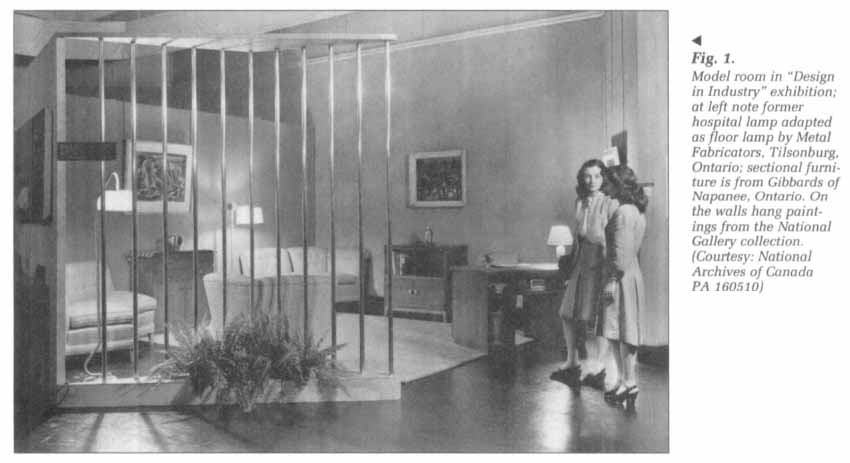 Display large image of Figure 1
Display large image of Figure 1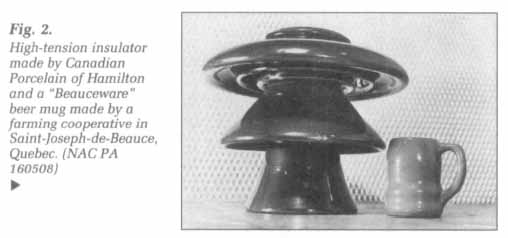 Display large image of Figure 2
Display large image of Figure 2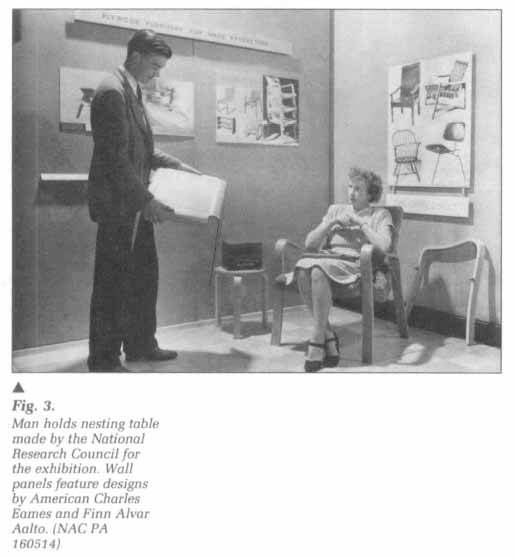 Display large image of Figure 3
Display large image of Figure 316 The use of selection criteria, whether they were rigorously applied or not, is a clear indication that Buchanan was seeking a serious audience for the consideration of Canadian design. Undoubtedly the programmes of the Museum of Modern Art in New York City (MOMA) served this purpose well as a curatorial model. Buchanan had probably borrowed the term "organic" from a 1941 MOMA juried exhibition featuring prototype plywood furniture, "Organic Design in Home Furnishings," for which a catalogue was published.19 MOMA was founded in 1929 and would seem to fit Haines' requirements for the ideal museum. It was a major proponent of industrial design, a supporter of Bauhaus design ideals and included in its charter a call for the study of modern art and the application of such arts to manufacture and practical life.20 To this end a Department of Architecture and Industrial Design was established in 1933, with Industrial Design evolving into a separate department in 1940. MOMA's prodigious publication and travelling exhibition programme would provide an important example for the National Gallery during the organization of "Design in Industry." Another published MOMA catalogue was of the 1934 exhibition, "Machine Art," an unprecedented tribute to the aesthetics of engineering design in such examples as ball bearings, springs and an airplane propellor.21
17 The "Design in Industry" exhibition followed the example of the "Machine Art" exhibition by the display of engineered objects such as works of decorative art. The ceramics section would feature a porcelain high-tension insulator made by Canadian Porcelain of Hamilton, Ontario (fig. 2). In the glass section, large globes made during the war for cathode-ray tubes were removed from their technical context and displayed solely to illustrate the aesthetic qualities of machine-blown glass. These globes had been manufactured by Research Enterprises Limited, the Canadian crown company formed in 1940, for a long-range-microwave aircraft-detection system. Research Enterprises, with the cooperation of the NRC, would undertake the production of the most sophisticated optical-glass products yet known in Canada. The globes would be shown together with Pyrex ovenware by Corning Glass to which Research Enterprises was sold in 1945.22
18 Bent-plywood furniture was patented in the United States as early as 1874, but it was not until the 1930s that it became a trademark material of Finnish designer Alvar Aalto. Aalto was a pioneer in the use of moulded plywood and laminated wood. His furniture was widely exhibited and published, establishing plywood as an acceptable material for living spaces. He used native woods extensively and was considered a representative of the modern Scandinavian school of design. Aalto's designs were to provide important models for prototype furniture in "Design in Industry."
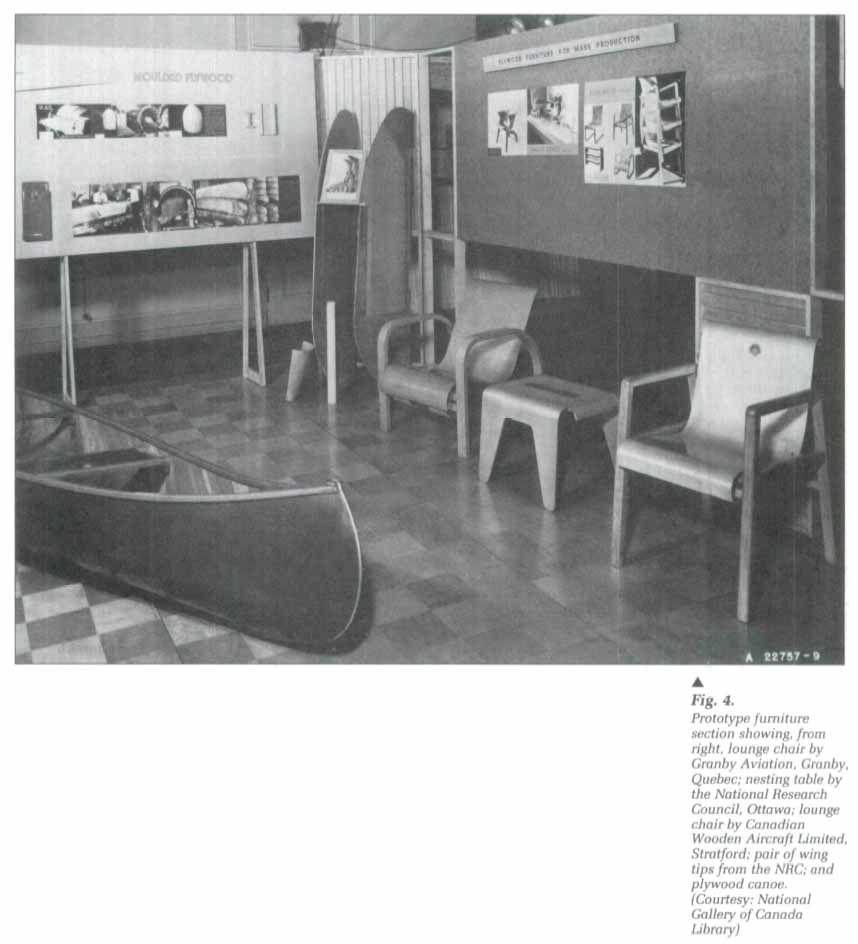 Display large image of Figure 4
Display large image of Figure 419 It was not until the aviation industry's heavy dependence on plywood during the Second World War that its moulding and manufacturing potential was fully understood in Canada. In 1940 the Structures Laboratory at the NRC was provided with the pilot plant to develop and demonstrate the use of synthetic adhesives and moulded plywood.23 Plywood would be used extensively by Canadian manufacturers for the Mosquito bomber made by de Havilland from a British design and the Avro Anson trainer built by Federal Aircraft Limited. At the height of the war five major Ontario furniture companies, including Imperial Rattan of Stratford, were introduced to moulded plywood in 1942 after plant conversion to undertake subcontracting of aircraft components. Lack of metal parts for furniture production had prompted the Furniture Manufacturers Association to negotiate with the Department of Munitions and Supply to secure greater involvement of the furniture industry in war production.24
20 The importance of the aviation industry in developing technologies for peacetime use was recognized by "Design in Industry" with a number of aviation exhibits in a variety of materials. The creative solution of adapting plywood for the more unpredictable peacetime furniture markets would be a key feature of the "Design in Industry" exhibition (fig. 4). The NRC supplied the exhibition with a pair of plywood wing tips and with a panel outlining the use of an autoclave in manufacturing plywood products. The future potential of plywood in the furniture industry was idealized in two prototype armchairs made by the Canadian Wooden Aircraft Company of Stratford and Granby Aviation Limited of Granby, Quebec, both based on the 1931 designs of Alvar Aalto. Aalto's chairs had been featured in a major retrospective of his work in 1938 held at the Museum of Modern Art in New York and were reproduced above the Canadian prototypes on didactic panels provided by MOMA.25 Each had been manufactured with the same techniques used to mould airplane fuselages, demonstrating the extraordinary possibility of bending a continuous sheet of varying thickness in more than one direction to form a single backrest and seat unit.
21 After the exhibition the Canadian Wooden Aircraft Limited produced another version of the Aalto plywood armchair supported with laminated cantilever legs.26 Active in peacetime only during the late 1940s, the company would retain its wartime name. It appeared in the 1948 City of Stratford Directory with the following description: "Canadian Wooden Aircraft Limited, Dr. H. Bonar, Sec-Treas; Mfrs of Furniture, Radio Cabinets and Consoles, 93 Trinity Phone 2720."27 By 1950 the Canadian Wooden Aircraft Company would be absorbed by Imperial Rattan Company Limited. This suggests it had been a branch of Imperial since 1942 when the company had restored an empty plant following the agreement with the Department of Munitions and Supply. During the late 1940s Imperial was producing a line of furniture with organic shapes, clean lines and smooth surfaces in solid birch that it marketed as "Imperial Modern." Interestingly, in 1940 Imperial Rattan had taken a step away from traditional styles when it manufactured a series of room settings to designs by Eliel Saarinen shown at the Robert Simpson Company's display "Apartments of Today."28 Saarinen, also Finish, was a leading member of the Modern Movement in Europe before emigrating; eventually he became the President of the Cranbrook Academy of Art in Michigan in 1932.
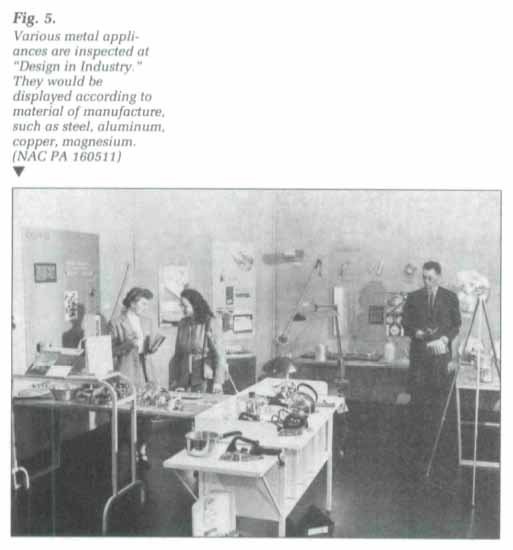 Display large image of Figure 5
Display large image of Figure 522 The ambitious examples of plywood furniture shown in "Design in Industry" expressed the inherent beauty of wood materials and clear structural form. They were, perhaps, a little too close to Alvar Aalto's original intention to be commercially successful, without risking copyright violation. Despite the exhibition's endorsement of plywood, it does not seem to have enjoyed a wide popular appeal in Canada for living areas during the 1950s without being heavily upholstered. One factor for lack of interest may have been the cost of making a prototype model. In 1948 this was estimated by the NRC to be a hundred dollars for a chair design of Harold Hicks featured in the "Design Centre" at the Canadian National Exhibition in Toronto.29 Another reason could have been fear of public opinion. At least one visitor to "Design in Industry" expressed her reservations about the novel design of the prototypes in a letter to the National Gallery: "I like plywood chairs as long as they avoid the modern tendency— established I think in Sweden—to be too recumbent. You can't carry on a conversation or read while either poking your head forward or gazing at the ceiling. "30 For whatever reason, industry was unwilling to take the risk of lowering per unit cost by mass production in an unproven market with an unconventional material.
23 Aluminum and magnesium would also prove to be important cross-over materials; these were produced during the war at record levels for aluminum aircraft components and bomb alloy and after the war for a great variety of industrially designed products. The aviation industry's role was again recognized in "Design in Industry" with the exhibit of an aircraft propellor made by the Aluminum Company of Canada's wartime plant in Kingston. Canada's prominence in this industry during the war was assisted through the cooperation of the NRC, in this case with Dominion Magnesium Limited. The latter had built a large plant at Haley, Ontario, near Renfrew, under the patronage of the CD. Howe's Wartime Metals Corporation in 1942, at a crucial period just after the United States had entered the war. During the 1930s aluminum ore had been produced from imported bauxite and great amounts of electricity, but at the Haley plant Dominion Magnesium was to take advantage of a new thermal method for extracting magnesium from dolomite developed at the NRC by Dr. Lloyd Pigeon.31
24 While Dominion Magnesium was heavily involved in refining, it was able to contribute manufactured products to "Design in Industry." These included an aluminum scooter and a cast piano plate hung on the wall like an abstract sculptural composition to demonstrate how lightweight it was. Another aluminum exhibit was a cantilever chair made by Precision Tool and Supply Company of Montréal, formerly involved in war contracts. Shown as a corrosive-free alternative to cast-iron garden furniture, it would be included in the travelling version of the show which circulated during 1947. "Design in Industry" would be hosted by, among others, T. Eaton Company stores across Canada and Henry Morgan and Company in Montréal, two important exhibitors of modern interior design during the 1930s.
25 Plastic was another material used by the aviation industry during the war to seal plywood aircraft fuselages and to manufacture Plexiglas domes. One of these by Duplate Limited of Oshawa was shown in the exhibition. Duplate, an important aviation supplier, was also represented as a peacetime manufacturer in the exhibition by examples of plastic refrigerator parts. Before the war plastic use was limited to tableware and bathroom items; while plywood at least had some material relationship to conventional hard-wood furniture, plastic furniture would require an enlightened outlook indeed. James Donahue, who had studied with Bauhaus graduate Marcel Brewer at Harvard University, undertook with Douglas Simpson the design for the NRC of a stacking chair (fig. 6) to show the potential of plastics in single-piece continuous construction. This process would be the aesthetic and technical goal of every designer during the post-war period. The chair reflects Brewer's knack for adapting new industrial materials, such as tubular steel in the 1920s, to produce low-cost, attractive furniture. It also recalls Brewer's stacking-chair designs in plywood for Isokon Furniture Company of London, England, from 1935 to 1937. Other original adaptations of Brewer's designs were Donahue's cutout plywood chair with webbed seat and back (seen to the right in fig. 9) and Simpson's nesting table (fig. 6), both manufactured by the NRC.
26 The plastic chair was made in the Structures Laboratory of the NRC from cotton laminations held together with plastic adhesives and topped with a fibreglass veneer and a final coating of airplane paint. Fibreglass would play an important role during the war in the constant attempts that were made to make lighter, more inexpensive aircraft. The "Design in Industry" exhibition featured a section of an aircraft pontoon, manufactured by the Fibre-glass Company of Oshawa for Fleet Aircraft of Fort Erie, Ontario (fig. 7). No doubt, it was displayed to suggest the potential of this material, which became a popular medium for innovative furniture during the 1950s.
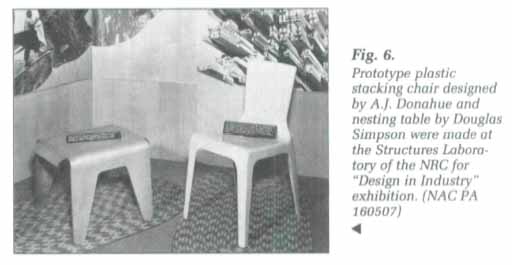 Display large image of Figure 6
Display large image of Figure 627 Two facts about the plastics industry in post-war Canada were reflected in the great variety of products displayed in "Design in Industry" (fig. 8). One was the rush of companies to break into the plastics industry. The other was the relative ease of converting plastics to peacetime manufacture, thus launching the plastic age of the 1950s. These products would include dinnerware by Maple Leaf Plastics of Toronto and Dominion Plastics of Montréal, a vinyl raincoat by Kelton Manufacturing of Toronto (until 1945 vinyl had been primarily used in Canada for the production of coatings for electrical wire), an artificial eye by Brent Labs of Toronto and brushes by the Prophylactic Company of Toronto.
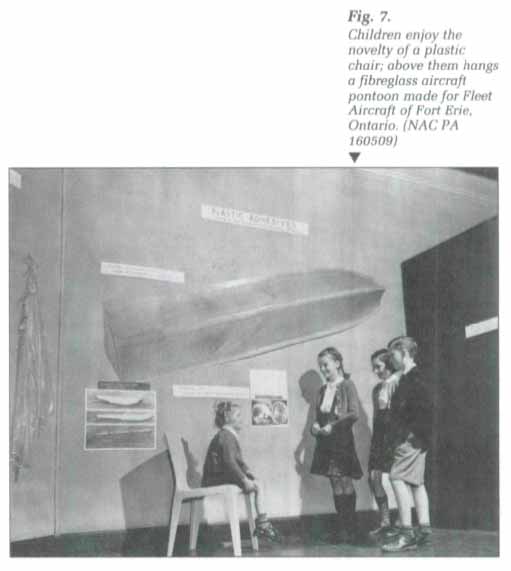 Display large image of Figure 7
Display large image of Figure 728 While "Design in Industry" included mass-produced objects of many kinds, most are more valuable today as nostalgia than as historical or aesthetic record. The exhibition of prototype furniture, however, was a remarkable and telling feature that deserves concluding discussion. Manufactured from materials essential to the development of the aviation industry during the war, these prototypes reflect a genuine attempt by companies to diversify and survive in a very much changed economic environment after the war. There was an apparent contradiction, however, in using these examples of costly "art" furniture to illustrate the exhibition's premise of "design for the millions." Significantly, the impact of leading design tendencies in new materials was found "futuristic."32 The "Design in Industry" exhibition was described as a showcase for the "merchandise of tomorrow."33 By featuring the most technologically and aesthetically advanced industrial design, the exhibition would follow the pattern of the Milan Triennale, an international show place for design begun in 1930, or such MOMA examples as "Organic Design in Home Furnishings" referred to above. Today of course, prototypes are a common sight at international industry trade shows. They are displayed to reflect a "state of the art" potential rather than what one can expect to be available from the following year's production line.
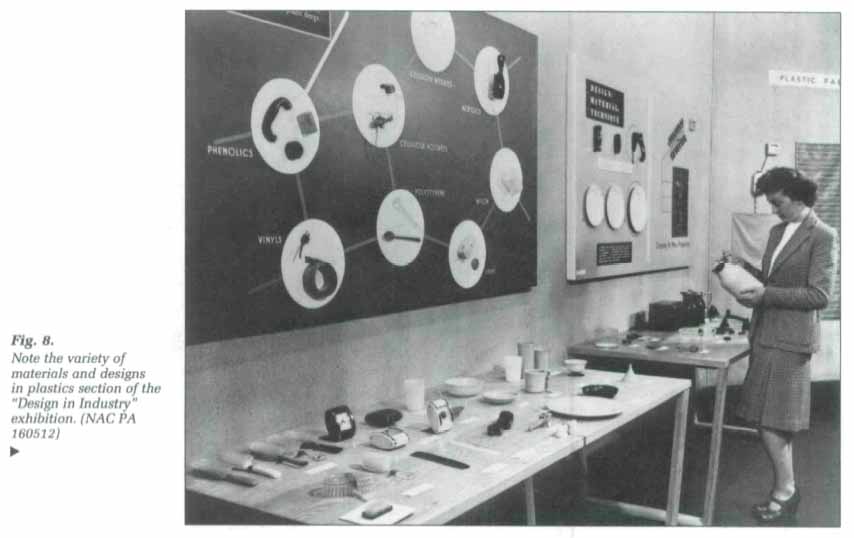 Display large image of Figure 8
Display large image of Figure 829 The fact that two different companies, Canadian Wooden Aircraft Limited and Granby Aviation, produced prototypes based on designs by Alvar Aalto must reflect a conscious decision to compare the Canadian and Finish furniture industries. Was it Buchanan's dependency on what MOMA decreed as good design or was there anything more deliberate about this decision? And in 1946 were these far-reaching ambitions perhaps an unattainable and impractical goal to expect of manufacturers in Canada? In 1947 Buchanan was to summarize his aspirations for industrial design in Canada as follows:
30 The inception of what Buchanan referred to as "the group of seven hundred" and the status of the professional consultant designer in Canada would be marked by the formation of an Affiliation of Canadian Industrial Designers in 1946. The founding members included A.J. Donahue and E.W. Thrift of Winnipeg, Watson Balharrie and Douglas Simpson of Ottawa, J.B. Parkin and George Englesmith of Toronto, Leo Skidmore Associates of London, and Henry Finkel and Jacques L. Bieler of Montréal.35
31 It is significant that Buchanan's belief in a national school of design coincided with widespread industrial development after the war. This development presented Canada with the opportunity of entering the international export market with more to offer than simply raw materials or energy resources. However, Canadian manufacturing was faced with competition from European countries fast recovering their industrial capacity. While organizing the "Design in Industry" exhibition Buchanan warned CD. Howe that "rapid steps are being taken in other countries," referring here to the Council of Industrial Design formed in Britain in 1944.36 The use of prototype furniture based on designs by Alvar Aalto and Marcel Breuer would convey the notion that it was possible to make Canada's manufactures more effective exports by projecting a sense of national design identity. By 1946 Aalto's furniture designs were a clear indication of Scandinavia's reputation for improving industrial products through good design. Scandinavian hardwood furniture generally enjoyed a wide popularity in Canada by the 1940s and was often featured in advertising campaigns by Simpsons and other department stores into the 1950s.
32 Furniture is often isolated to reflect changing cultural trends and technology because it is one of the more pervasive and essential of consumer products. If Buchanan was to demonstrate the possibilities of a national school of design, it would be in the interior of a home where the decisions of a generation to adapt to new economic realities is most clear. This would be a crucial issue in post-war Canada when there was an enormous demand for housing and inexpensive standardized furnishings for sale to families of modest incomes. Finland, Germany and Sweden had already confronted this problem before the war and it was then that designers such as Alvar Aalto and Marcel Breuer established their reputations and respect for the national traditions that characterized their work abroad. During the House of Commons Hearings on Reconstruction and Reestablishment in 1944, Sweden had been recognized as a "world cultural power" because it had "projected an idea through the national slogan: 'Art in everyday things.'"37
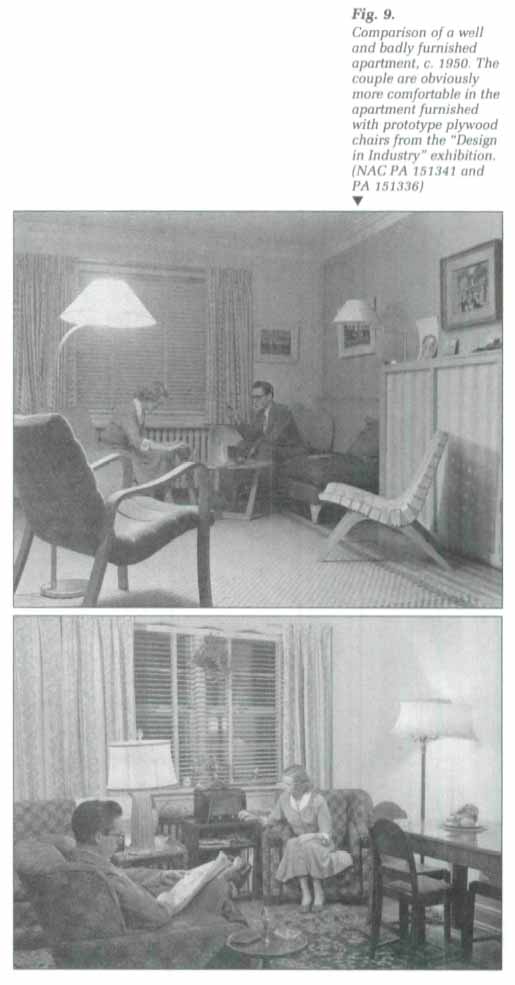 Display large image of Figure 9
Display large image of Figure 933 The encouragement of a Canadian school of design was surely one of the National Gallery's initial goals in developing the programmes of the National Industrial Design Committee in 1948, with representatives from business, government, industry and design. The National Industrial Design Committee would continue the pattern of public and private sector cooperation that was evident in the "Design in Industry" exhibition between the NRC and the aviation industry during the war.38 One of its tasks would be to educate the public to accept modern design in new materials, thus establishing a market for a Canadian school of design. This novel service in the national interest could only be justified under the direction of the National Gallery, responsible since its founding in 1913 for cultivating "correct artistic taste."39
34 The comparison of badly designed furniture with that which met certain approved aesthetic criteria was a common device in the propaganda campaign for modern design during the 1940s. It was used in MDMA exhibitions and publications and in the "Britain Can Make It" exhibition of 1945, organized in London, England, by the Council of Industrial Design. As secretary of the National Industrial Design Council, Buchanan would adopt this approach. Traditional and completely uninspiring upholstered furniture was compared and criticized beside prototype examples from the "Design in Industry" exhibition (fig. 9). The couple who inhabited the refurnished apartment, as shown in figure 9, were the more fortunate, claimed Buchanan, because they avoided a false impression of luxury and sought out household equipment that "combined true comfort and delight in appearance."40 The modern room settings were enhanced with paintings that reflected a continued interest in landscape in addition to the abstract relationships of form, line and colour—the implication being that this couple sought out those artists and designers who most clearly embodied the possibilities of a modern Canadian cultural nationalism.